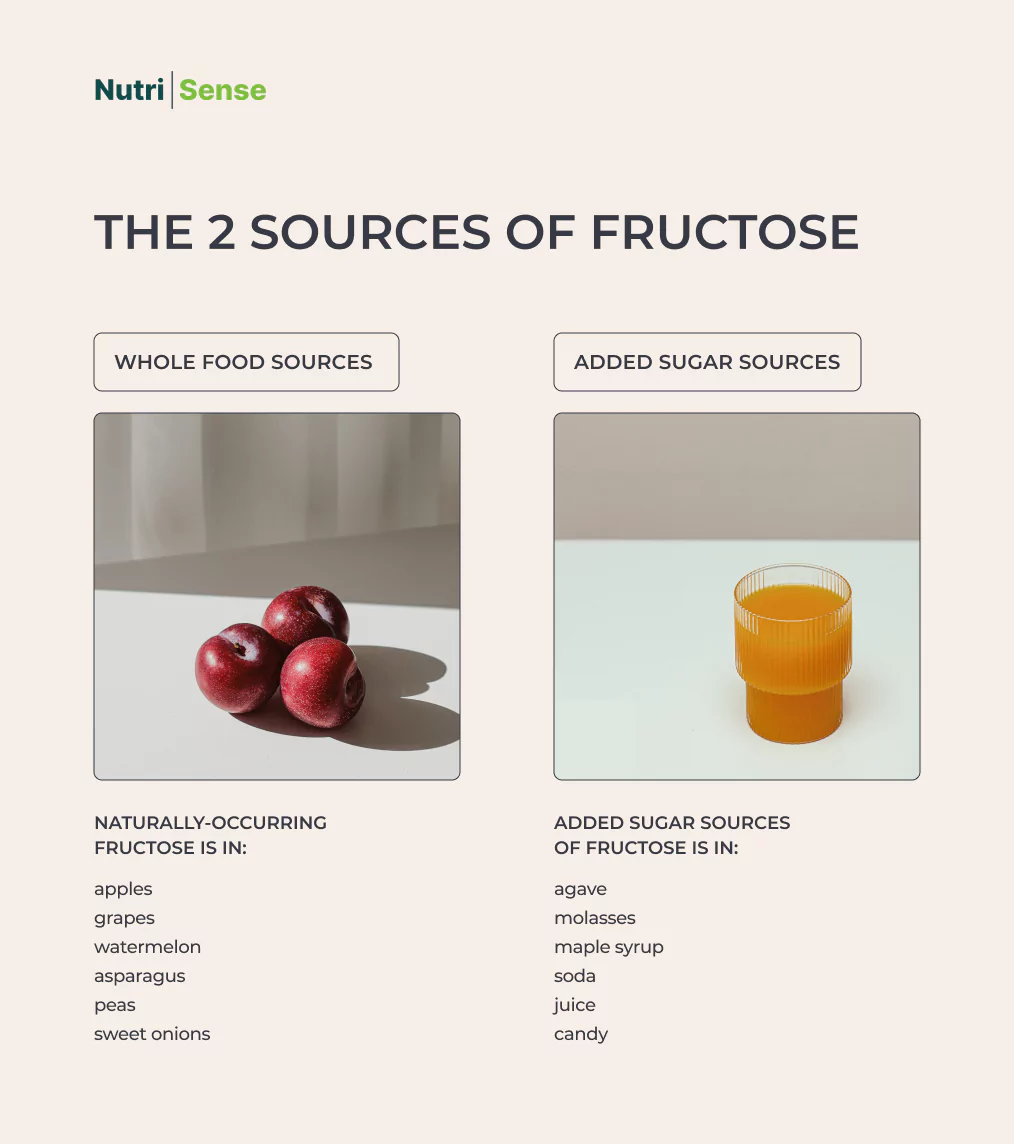Fructose: The Sweet Truth About Its Effects on Your Health
.webp)
Key Takeways
Studies show that one-fourth of children in the United States consume more than the recommended daily intake of sweeteners. That's a lot! And, it doesn't help that cases of insulin resistance in young adults are rising.
There are many different names for sugar, but one you’ve probably heard of before is fructose. Fructose is the sweetest-tasting type of sugar, and a variation known as high-fructose corn syrup is one of the most controversial sweeteners in the United States.
So, what exactly is fructose, and where does it come from? Does consuming fructose cause blood sugar spikes? And is it really that bad for you?
Read on to learn more about how this type of sugar affects the body.
What is Fructose?
Fructose is a naturally occurring type of sugar, typically found in fruits and vegetables. Because it’s so commonly found in fruits, fructose is sometimes called “fruit sugar.”
Similar to glucose, fructose is a type of carbohydrate, and it’s classified as a monosaccharide or simple sugar. However, research has shown that fructose has a much smaller impact on blood sugar levels and insulin release than glucose.
Let’s have a closer look at which foods contain fructose.
The 2 Sources of Fructose

There are two types of fructose, and you're likely to find it as both a source of natural sugar and as an added sugar. Natural fructose comes from whole food sources like fruits, while added fructose is in manufactured and processed products.
Whole Food Sources
Naturally-occurring fructose is in foods like apples, grapes, watermelon, asparagus, peas, and sweet onions. Research shows that naturally occurring fructose found in whole foods do not have a harmful effect on health when eaten according to guidelines.
The 2020-2025 Dietary Guidelines for Americans recommend that adults consume one and a half to two cups of fruit and two to three cups of vegetables per day. However, apart from providing you with fructose, eating fruits and vegetables are also good sources of fiber, phytochemicals, vitamins, and minerals.
Added Sugar Sources
Added sugar sources of fructose, which can include high fructose corn syrup or sucrose, is in things like agave, honey, molasses, and maple syrup. This food additive is also commonly added to soda, juice, and candy.
As we mentioned in our article on added sugar, the American Heart Association recommends limiting added sugar to less than six percent of your daily calorie intake. If you’re on a 2,000-calorie diet, this would be about 120 calories or less.
The side effects of high levels of high fructose corn syrup consumption can include weight gain, poor blood sugar regulation, and more. Weight gain from high-calorie foods containing HFCS is associated with increased risks of heart disease, diabetes, fatty liver disease, and abnormal lipid levels in the blood.
Fructose vs. Glucose vs. Sucrose: What’s the Difference?

We often talk about glucose and the effect of certain foods on your blood sugar levels. But what about fructose and sucrose? How are these types of sugar different, and how do they affect your health?
Glucose: The Lifeblood of Energy
Glucose and fructose are both types of sugar that occur naturally in many foods. Foods that contain glucose are broken down and metabolized to be used for energy, causing glucose levels in the blood to rise.
On the other hand, glucose transporters in the small intestine still absorb fructose. It’s also partially digested by the liver and doesn’t immediately trigger an insulin response when consumed. This is because fructose must first be converted into glucose in the liver before your body can use it for energy.
Sucrose: The Combination of Both
Sucrose, or standard table sugar, is a disaccharide consisting of one glucose and one fructose molecule. It can be found naturally in whole foods and sometimes added into processed foods as a form of added sugar.
Sucrose is in fruits, plants, and nuts, such as sugar cane, sugar beets, honey, and maple syrup. Sucrose can cause a spike in blood sugar, similar to glucose consumption, as half of its contents are made up of glucose.
How Harmful is Fructose? Is it Bad for You?
You can consume fructose as part of a healthy, balanced diet, but like most things, moderation is key. Weight gain, moodiness, digestive issues, cavities, and acne may all be signs you might be eating too much sugar.
As discussed, fructose from whole food sources may be safe to consume in moderation for most people. However, limiting added sugar sources of fructose or any other type of added sugar is a good idea, as consuming too much can lead to adverse health effects.
Studies have found that excessive fructose consumption may lead to obesity, chronic inflammation, non-alcoholic fatty liver disease, and insulin resistance. While fructose has a lower glycemic index compared to pure glucose and may result in a relatively lower spike in blood sugar for some, too much fructose can instead have detrimental effects on the liver.
As for high fructose corn syrup (HFCS), this variation of fructose gets a particularly bad reputation in the health world. However, the vast majority of HFCS is not biologically different from regular table sugar in terms of its fructose content. In fact, the most common types of HFCS (42 and 55) have an equivalent fructose content to sucrose.
The Negative Effects of Excessive Fructose

Now that you know what fructose is and where it comes from, let’s explore how and why this type of sugar can negatively affect your health when consumed in excess.
Non-Alcoholic Fatty Liver Disease (NAFLD)
Non-alcoholic fatty liver disease is an indicator of metabolic syndrome. This condition can cause symptoms such as fatigue, abdominal swelling, enlarged blood vessels, and yellowing of the skin.
One study determined that one of the biggest risk factors for developing NAFLD is high dietary sugar intake. It's because excessive fructose consumption can cause fat to accumulate in the liver and block hepatic fatty acid oxidation.
The same study also showed that developing more severe NAFLD is even more likely when you pair high fructose intake with a high-fat diet. Individuals with obesity or diabetes are also more likely to develop NAFLD.
Hepatic Insulin Resistance
Fructose consumption is also linked to hepatic insulin resistance. This form of insulin resistance is also a risk factor for NAFLD, cardiovascular disease, and for developing metabolic syndrome.
Excess fructose consumption can cause chronic inflammation and modify liver lipid consumption. Research has shown that inflammation paired with obesity both have links to hepatic insulin resistance.
Various studies have been conducted to support the findings and observe the effects of fructose supplementation in healthy individuals. In one, they found that consuming 250 grams of fructose daily for seven days decreased insulin sensitivity in the subjects.
Decreased Glucose Tolerance
Decreased glucose tolerance occurs when your glucose levels are abnormally elevated, but you have not been diagnosed with diabetes. Factors such as obesity, low activity levels, high blood pressure, or a family history of diabetes can increase your risk of having chronically elevated glucose levels.
Excessive fructose consumption, while not always affecting your blood glucose levels, has been linked to weight gain, increased risk of obesity, and insulin resistance. Because of these associations, consuming high amounts of fructose can contribute to impaired glucose and other risk factors of metabolic syndrome.
Leptin Resistance
Leptin is a hormone that helps your body regulate hunger and manage weight. High dietary levels of fructose also have links to a condition called leptin resistance.
In a study on mice, chronic fructose consumption led to leptin resistance and subsequent weight gain. It may be because high fructose intake can increase the number of triglycerides in the blood and block leptin from reaching the brain.
However, since these were animal studies, more research may still be needed to determine if this same association is true among humans.
Examples of Foods with Fructose
It’s important to know the nutritional value of the foods you eat, especially regarding high-sugar foods. Here’s a list of some of the most common sources of fructose.
Whole Food Sources of Fructose

These are some examples of common fruits and vegetables that contain fructose. Many of these foods are also high in vitamins, fiber, and in minerals like calcium, potassium, and magnesium.
- Apples
- Cherries
- Grapes
- Guava
- Honeydew melon
- Watermelon
- Mangoes
- Papaya
- Pears
- Persimmon
- Pineapple
- Artichokes
- Asparagus
- Beans
- Broccoli
- Cabbage
- Onions
Added Sugar Sources of Fructose

Here are some of the common types of foods that can contain added fructose. Remember that while some of these products often include high fructose corn syrup, the use of HFCS may vary depending on the brand.
- Soda
- Fruit juice
- Candy
- Granola bars
- Jams and jellies
- Bread and crackers
- Apple sauce
- Maple syrup
- Honey
- Nut butter
- Condiments such as ketchup
Better Understand your Dietary Choices with Nutrisense
There are many different types of sugar out there. If you want to learn more about how the foods you eat may be impacting your blood sugar, a continuous glucose monitor (CGM) can help.
The Nutrisense program will supply you with a CGM that allows you to track your blood sugar levels in real-time, giving you access to data you can read in the handy Nutrisense app. When you sign up, you’ll also be paired with a credentialed dietitian or nutritionist to support you on your wellness journey.
Learn more about how you can optimize your diet and reach your wellness goals with Nutrisense today.
Find the right Nutrisense programto turn insight into progress.
Go Beyond Glucose Data with Nutrisense
Your glucose can significantly impact how your body feels and functions. That’s why stable levels are an important factor in supporting overall wellbeing. But viewing glucose isn't enough. Nutrisense, you’ll be able to learn how to use your body's data to make informed lifestyle choices that support healthy living.
One-to-one coaching
Sign up to access insurance-covered video calls to work with a glucose expert: a personal registered dietitian or certified nutritionist who will help tailor your lifestyle and diet to your goals.
Monitor and measure what matters
With the Nutrisense CGM Program, you can monitor your glucose with health tech like glucose biosensors and continuous glucose monitor (CGM)s, and analyze the trends over time with the Nutrisense App. This will help you make the most informed choices about the foods you consume and their impact on your health.
Find your best fit
Ready to take the first step? Start with our quiz to find the right Nutrisense program to help you take control.

Heather is a Registered and Licensed Dietitian Nutritionist (RDN, LDN), subject matter expert, and technical writer, with a master's degree in nutrition science from Bastyr University. She has a specialty in neuroendocrinology and has been working in the field of nutrition—including nutrition research, education, medical writing, and clinical integrative and functional nutrition—for over 15 years.




